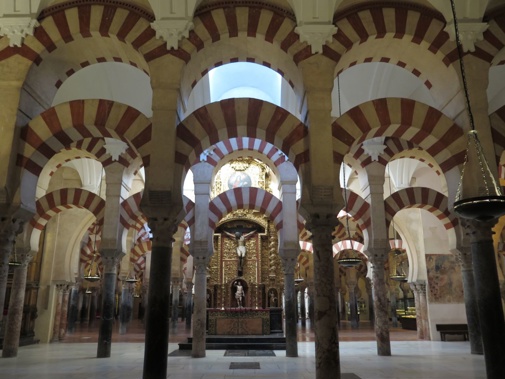
In the eyes of visitors, Andalucía’s enduring allure is legendary, but the textured, atmospheric appeal of Southern Spain is spectacularly illustrated in effortlessly explorable Cordoba. I based myself in the heart of the old city, at a cheap and cheerful 2-star establishment, Hotel Boston, from where I lapped up the sights like a perky cub-scout. Cordoba is the sort of place that seduces you, from the moment you arrive. To get an absorbing overview, jump onboard a City Sightseeing Hop-on Hop-off Bus.
A thousand years ago, Cordoba formed the heart of theWestern Islamic Empire, as capital of the Moorish kingdom of Al-Andulus. At its peak , Cordoba was home to half a million residents, making it Western Europe’s biggest city. That’s what really surprised me, because even though it’s still got plenty of bustle, Cordoba exudes a human-scale mystique. The star attraction is unquestionably the storied Mezquita, not dissimilar to Istanbul’s Hagia Sophia, whereby you’re rewarded by a 2-in-1 mosque and cathedral combo.
Built in 783AD by the Moorish conquerors on the site of a very early Christian church, they demolished the church to create this artistic treasure, which they wanted to rival the world’s great mosques. Entering its cavernous expanse, I was transfixed by its vast forest of pillars and horse shoe arches, which look a bit like candy canes, with a two toned ochre and cream colour scheme. When the Spanish Catholics reconquered Cordoba, mercifully, they didn’t destroy the building, opting instead to hide the minaret within a new bell tower, and plonking a church within the mosque’s existing fabric.
Fast forward a thousand years and a major sticking point today is that Muslims cannot pray in the Mezquita, given it’s a practising Catholic church. They’ve appealed to the Vatican to grant them a prayer room, without success. Several years ago, a group of Muslim tourists started mass-praying within the building, causing a huge stink, which resulted in several security guards being stabbed. How sad that such an incredible masterpiece of world heritage is racked with resentment, which underscores Spain’s inner-turmoil about its contested sense of identity and shared history. If you want to marvel at this building, before the ravenous hordes of tourists swamp it, jump up early and enjoy the early morning free admission, between 8.30am and 10am.
Beyond the Mezquita, lose yourself in the time-honoured Juderia, the Old Jewish quarter. This labyrinthine neighbourhood of twisting laneways is not overtly touristy or commercialised. You can also see the 13th century synagogue which was converted into a church, when the Spanish monarchy expelled the Jews from Spain. It’s the perfect place to wander aimlessly, in the maze of cobbled lanes with shady flower-filled courtyards. It’s peaceful, timeless and quintessential Cordoba.
Another reason to rise early, is to hot-foot it down Puente Romano. Spanning the Guadalquivir River, this grand old Roman Bridge turns on a celestial light show. In a scene straight out of a fairytale, as the rays of the rising sun caresses the honey-hued limestone bridge, the resulting mirror reflection on the water, produces a sensational “river of gold” mirage. Much of Cordoba’s medieval architecture is constructed in the honey-coloured stone, so the magic hours of the rising and setting sun create a photogenic feast.
Central to the local way of life is the cherished – even revered - patio. Throughout most of May the annual Festival of the Patios is a source of incredible local pride , and a monumental tourist draw. Even back in the days of the Romans, Cordoba homes were built with a central patio or courtyard, as a trusty refuge from the scorching heat. The tradition was enhanced by the Moors, with stone mosaics, ceramic tiles and water features, vividly accentuating the decorative touches to the patios. In fact, if you’ve been to Morocco, Cordoba patios are very reminiscent of those trademark courtyards of riads in Marrakech. May is a magical month to plan a visit to the city, when over fifty patios, tucked away behind heavy doors and iron gates, are thrown open for public viewing, for free. It’s a tantalising encounter with authentic Cordoba living and you’ll notice that patio decoration is not only a big business , but powered by plenty of “keeping up with the Joneses” rivalry.
Take your Radio, Podcasts and Music with you









